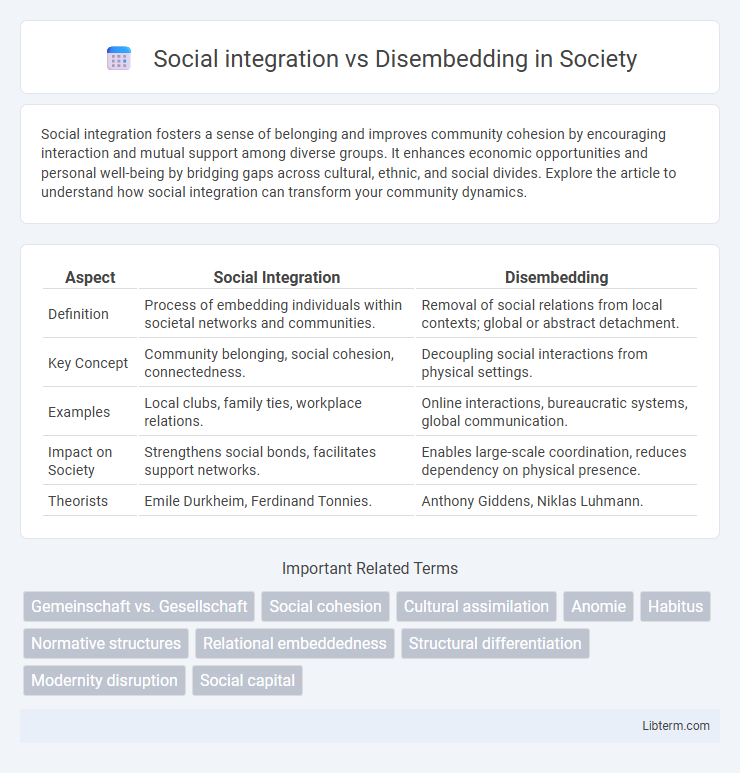Social integration fosters a sense of belonging and improves community cohesion by encouraging interaction and mutual support among diverse groups. It enhances economic opportunities and personal well-being by bridging gaps across cultural, ethnic, and social divides. Explore the article to understand how social integration can transform your community dynamics.
Table of Comparison
| Aspect | Social Integration | Disembedding |
|---|---|---|
| Definition | Process of embedding individuals within societal networks and communities. | Removal of social relations from local contexts; global or abstract detachment. |
| Key Concept | Community belonging, social cohesion, connectedness. | Decoupling social interactions from physical settings. |
| Examples | Local clubs, family ties, workplace relations. | Online interactions, bureaucratic systems, global communication. |
| Impact on Society | Strengthens social bonds, facilitates support networks. | Enables large-scale coordination, reduces dependency on physical presence. |
| Theorists | Emile Durkheim, Ferdinand Tonnies. | Anthony Giddens, Niklas Luhmann. |
Understanding Social Integration
Social integration refers to the process by which individuals and groups become incorporated into the social structure, fostering a sense of belonging and shared identity. Understanding social integration involves analyzing factors such as social networks, cultural norms, and institutional participation that promote cohesion within communities. Its study is crucial for addressing social fragmentation and enhancing collective well-being in increasingly diverse societies.
Defining Disembedding in Modern Societies
Disembedding in modern societies refers to the process where social relations are lifted out of localized contexts and restructured across time and space through abstract systems like money and bureaucratic institutions. This transformation allows interactions to occur independently of physical presence, enabling large-scale social coordination beyond face-to-face communities. Understanding disembedding highlights how contemporary social structures rely on impersonal mechanisms that detach individual relationships from direct social integration.
Historical Evolution of Social Ties
Social integration refers to the process through which individuals and groups become connected and participate in the social fabric, fostering cohesive and stable communities. In historical contexts, social ties evolved from kinship-based and face-to-face interactions toward more abstract and large-scale networks, a shift described by sociologist Ulrich Beck as disembedding, where social relations are lifted out of localized contexts. This transformation reflects the impact of modernization, urbanization, and globalization on social structures, altering how trust and cooperation are maintained across diverse and impersonal environments.
Key Differences: Integration vs. Disembedding
Social integration involves cohesive bonds linking individuals through shared norms, values, and institutions, fostering community and collective identity. Disembedding refers to the process where social relations are lifted out of local contexts and reorganized across broader temporal and spatial dimensions, often through abstract systems like money or bureaucracies. Key differences lie in integration emphasizing localized, face-to-face social ties, whereas disembedding facilitates distant interactions mediated by impersonal mechanisms that transcend immediate social environments.
Social Integration in Digital Age
Social integration in the digital age enhances connectivity by fostering online communities and enabling diverse social interactions through platforms like social media and virtual forums. This connectivity supports identity formation and collective action across geographical boundaries, increasing social capital and cohesion. Digital tools facilitate real-time communication and information exchange, promoting inclusive participation and reducing social isolation in modern societies.
Disembedding and Globalization
Disembedding refers to the process by which social relations are lifted out of local contexts and restructured across indefinite spans of time and space, a key feature of globalization. This phenomenon enables global flows of information, capital, and culture, dissolving traditional boundaries and embedding social interactions within global networks. Globalization accelerates disembedding by facilitating economic interdependence and cultural exchange, transforming local societies into interconnected nodes of worldwide systems.
Impacts on Community Cohesion
Social integration fosters community cohesion by enhancing shared values, trust, and collaborative networks, thus strengthening social bonds. In contrast, disembedding, characterized by detachment from local contexts and individualization, weakens community ties and reduces collective identity. The shift from embedded local interactions to abstract, global connections often undermines traditional forms of social solidarity and communal support systems.
Challenges to Social Integration Today
Social integration faces significant challenges today due to increasing globalization and digital disembedding, which weaken traditional community bonds and shared norms. The rise of virtual interactions and fragmented social networks complicates the development of trust and collective identity essential for cohesive societies. Addressing these issues requires innovative policies that balance online connectivity with fostering face-to-face social capital and inclusive institutional frameworks.
Strategies for Balancing Integration and Disembedding
Effective strategies for balancing social integration and disembedding include fostering community engagement while embracing technological innovation that allows for flexible connections beyond traditional boundaries. Facilitating inclusive communication channels and promoting cultural adaptability strengthens local identity without sacrificing global interaction. Implementing policies that support both face-to-face interactions and digital connectivity ensures a dynamic equilibrium between cohesive social bonds and autonomous individual participation.
Future Outlook for Social Structures
The future outlook for social structures will be shaped by the balance between social integration and disembedding, where increasing digital connectivity fosters global networks while simultaneously challenging traditional face-to-face community bonds. Advances in technology and globalization promote new forms of social capital and networked interactions that transcend geographical boundaries, but may also contribute to social fragmentation and weakened local identities. Understanding this dynamic is crucial for developing policies that enhance cohesion without stifling innovation in evolving social frameworks.
Social integration Infographic

 libterm.com
libterm.com